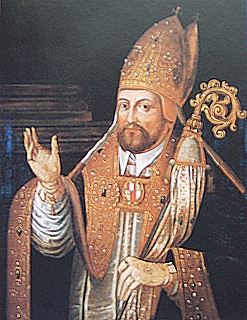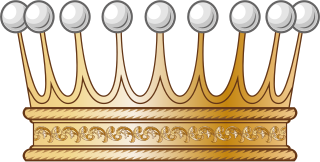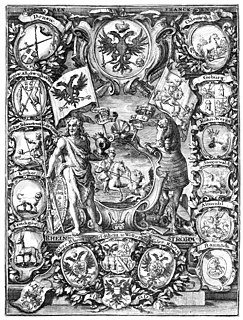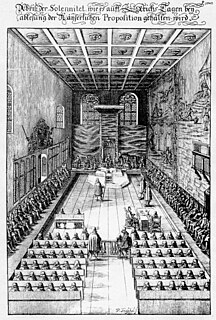
A prince-bishop is a bishop who is also the civil ruler of some secular principality and sovereignty. Thus the principality or prince-bishopric ruled politically by a prince-bishop could wholly or largely overlap with his diocesan jurisdiction, but some parts of his diocese, even the city of his residence, could be exempt from his civil rule, obtaining the status of free imperial city. If the episcopal see is an archbishop, the correct term is prince-archbishop; the equivalent in the regular (monastic) clergy is prince-abbot. A prince-bishop is usually considered an elected monarch.
A prince is a male ruler or a male member of a monarch's or former monarch's family. Prince is also a title of nobility, often hereditary, in some European states. The feminine equivalent is a princess. The English word derives, via the French word prince, from the Latin noun prīnceps, from primus (first) and capio, meaning "the first, foremost, the chief, most distinguished, noble ruler, prince".

Graf is a historical title of the German nobility, usually translated as "count". Considered to be intermediate among noble ranks, the title is often treated as equivalent to the British title of "earl".

An Imperial State or Imperial Estate was a part of the Holy Roman Empire with representation and the right to vote in the Imperial Diet. Rulers of these Estates were able to exercise significant rights and privileges and were "immediate", meaning that the only authority above them was the Holy Roman Emperor. They were thus able to rule their territories with a considerable degree of autonomy.
The mediatised houses were ruling princely and comital-ranked houses which were mediatised in the Holy Roman Empire during the period of 1803–1815 as part of German mediatisation, and were later recognised in 1825–1829 by the German ruling houses as possessing considerable rights and rank. With few exceptions, these houses were those whose heads held a seat in the Imperial Diet when mediatised during the establishment of the Confederation of the Rhine in 1806–07, by France in 1810, or by the Congress of Vienna in 1814–15. The mediatised houses were organised into two ranks: the princely houses, entitled to the predicate Durchlaucht, which previously possessed a vote on the Bench of Princes (Furstenbank); and the comital houses which were accorded the address of Erlaucht, which previously possessed a vote in one of the four Benches of Counts (Gräfenbank). Whilst some form of mediatisation occurred in other countries, such as France, Italy and Russia, only designated houses within the former Holy Roman Empire legally comprised the mediatised houses.
Imperial immediacy was a privileged constitutional and political status rooted in German feudal law under which the Imperial estates of the Holy Roman Empire such as Imperial cities, prince-bishoprics and secular principalities, and individuals such as the Imperial knights, were declared free from the authority of any local lord and placed under the direct authority of the Holy Roman Emperor, and later of the institutions of the Empire such as the Diet, the Imperial Chamber of Justice and the Aulic Council.

German mediatisation was the major territorial restructuring that took place between 1802 and 1814 in Germany and the surrounding region by means of the mass mediatisation and secularisation of a large number of Imperial Estates. Most ecclesiastical principalities, free imperial cities, secular principalities, and other minor self-ruling entities of the Holy Roman Empire lost their independent status and were absorbed into the remaining states. By the end of the mediatisation process, the number of German states had been reduced from almost 300 to just 39.

During the Middle Ages, an advocatus was an office-holder who was legally delegated to perform some of the secular responsibilities of a major feudal lord, or for an institution such as an abbey. Many such positions developed, especially in the Holy Roman Empire. Typically, these evolved to include responsibility for aspects of the daily management of agricultural lands, villages and cities. In some regions, advocates were governors of large provinces, sometimes distinguished by terms such as Landvogt.

Prince of the Holy Roman Empire was a title attributed to a hereditary ruler, nobleman or prelate recognised as such by the Holy Roman Emperor.
In the law of the Middle Ages and early Modern Period and especially within the Holy Roman Empire, an allod, also allodial land or allodium, is an estate in land over which the allodial landowner (allodiary) had full ownership and right of alienation.

The Free Imperial knights were free nobles of the Holy Roman Empire, whose direct overlord was the Emperor. They were the remnants of the medieval free nobility (edelfrei) and the ministeriales. What distinguished them from other knights, who were vassals of a higher lord, was the fact that they had been granted Imperial immediacy, and as such were the equals in most respects to the other individuals or entities, such as the secular and ecclesiastical territorial rulers of the Empire and the Free Imperial cities, that also enjoyed Imperial immediacy. However, unlike all of those, the Imperial knights did not possess the status of Estates (Stände) of the Empire, and therefore were not represented, individually or collectively, in the Imperial Diet.They tended to define their responsibilities to the Empire in terms of feudalized obligations to the Emperor, including personal service and strictly voluntary financial offerings paid to the Emperor himself.

The house of Limburg Stirum, which adopted its name in the 12th century from the immediate county of Limburg an der Lenne in what is now Germany, is one of the oldest families in Europe. It is the eldest and only surviving branch of the House of Berg, which was among the most powerful dynasties in the region of the lower Rhine during the Middle Ages. Some historians link them to an even older dynasty, the Ezzonen, going back to the 9th century.

A heerlijkheid was a landed estate that served as the lowest administrative and judicial unit in rural areas in the Dutch-speaking Low Countries before 1800. It originated as a unit of lordship under the feudal system during the Middle Ages. The English equivalents are manor, seigniory, and lordship. The German equivalent is Herrschaft. The heerlijkheid system was the Dutch version of manorialism that prevailed in the Low Countries and was the precursor to the modern municipality system in the Netherlands and Flemish Belgium.

The Imperial Diet was the deliberative body of the Holy Roman Empire. It was not a legislative body in the contemporary sense; its members envisioned it more like a central forum where it was more important to negotiate than to decide.

Imperial Count was a title in the Holy Roman Empire. In the medieval era, it was used exclusively to designate the holder of an imperial county, that is, a fief held directly (immediately) from the emperor, rather than from a prince who was a vassal of the emperor or of another sovereign, such as a duke or prince-elector. These imperial counts sat on one of the four "benches" of Counts, whereat each exercised a fractional vote in the Imperial Diet until 1806.

The prince regnant of Liechtenstein is the monarch and head of state of Liechtenstein. The Liechtenstein family, after which the sovereign principality was named in 1719, hails from Liechtenstein Castle in Lower Austria, which the family possessed from at least 1140 to the thirteenth century, and from 1807 onward. It is the only remaining European monarchy that practises strict agnatic primogeniture.
The Lordship of Gedern was a lordship or herrschaft centred on Gedern near Büdingen in Hesse, Germany. It is first recorded in a document from Lorsch Abbey dating to 780.

The Lordship of Schellenberg was a historic state of the Holy Roman Empire, now located in the Principality of Liechtenstein. Its capital was the town of Schellenberg.
In the Holy Roman Empire, Landeshoheit or superioritas territorialis was the authority possessed by the immediate lords within their own territories. It was possessed by all imperial estates and imperial knights. It has often been conflated with sovereignty but while it "carried with it nearly all the ingredients or attributes of true sovereignty, [it] was legally distinct from it, and was everywhere in Germany admitted to be so."













